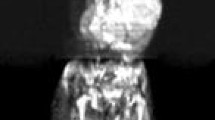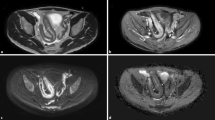Abstract
Diffusion-weighted MRI is being increasingly used in pediatric body imaging. Its role is still emerging. It is used for detection of tumors and abscesses, differentiation of benign and malignant tumors, and detection of inflamed bowel segments in inflammatory bowel disease in children. It holds great promise in the assessment of therapy response in body tumors, with apparent diffusion coefficient (ADC) value as a potential biomarker. Significant overlap of ADC values of benign and malignant processes and less reproducibility of ADC measurements are hampering its widespread use in clinical practice. With standardization of the technique, diffusion-weighted imaging (DWI) is likely to be used more frequently in clinical practice. We discuss the principles and technique of DWI, selection of b value, qualitative and quantitative assessment, and current status of DWI in evaluation of disease processes in the pediatric body.













Similar content being viewed by others
References
Koh DM, Collins DJ (2007) Diffusion-weighted MRI in the body: applications and challenges in oncology. AJR Am J Roentgenol 188:1622–1635
Qayyum A (2009) Diffusion-weighted imaging in the abdomen and pelvis: concepts and applications. Radiographics 29:1797–1810
Taouli B, Koh DM (2010) Diffusion-weighted MR imaging of the liver. Radiology 254:47–66
Chavhan GB, Alsabban Z, Babyn PS (2014) Diffusion-weighted imaging in pediatric body MR imaging: principles, technique, and emerging applications. Radiographics 34:E73–E78
Takahara T, Imai Y, Yamashita T et al (2004) Diffusion weighted whole body imaging with background body signal suppression (DWIBS): technical improvement using free breathing, STIR and high resolution 3D display. Radiat Med 22:275–282
Kwee TC, Takahara T, Ochiai R et al (2009) Diffusion-weighted whole-body imaging. Eur J Radiol 70:409–417
Le Bihan D, Breton E, Lallemand D et al (1986) MR imaging of intra-voxel incoherent motions: application to diffusion and perfusion in neurologic disorders. Radiology 161:401–407
Koh DM, Collins DJ, Orton MR (2011) Intravoxel incoherent motion in body diffusion-weighted MRI: reality and challenges. AJR Am J Roentgenol 196:1351–1361
Alibek S, Cavallaro A, Alpas A et al (2009) Diffusion weighted imaging of pediatric and adolescent malignancies with regards to detection and delineation: initial experience. Acad Radiol 16:866–671
Humphries PD, Sebire NJ, Siegel MJ et al (2007) Tumors in pediatric patients at diffusion-weighted MR imaging: apparent diffusion coefficient and tumor cellularity. Radiology 245:848–854
Uhl M, Altehoefer C, Kontny U et al (2002) MRI-diffusion imaging of neuroblastomas: first results and correlation to histology. Eur Radiol 12:2335–2338
Gahr N, Darge K, Hahn G et al (2011) Diffusion-weighted MRI for differentiation of neuroblastoma and ganglioneuroblastoma. Eur J Radiol 79:443–446
Gawande RS, Gonzalez G, Messing S et al (2013) Role of diffusion-weighted imaging in differentiating benign and malignant pediatric abdominal tumors. Pediatr Radiol 43:836–845
Kocaoglu M, Bulakbasi N, Sanal HT et al (2010) Pediatric abdominal masses: diagnostic accuracy of diffusion weighted MRI. Magn Reson Imaging 28:629–636
Miquel ME, Scott AD, Macdougall ND et al (2012) In vitro and in vivo repeatability of abdominal diffusion-weighted MRI. Br J Radiol 85:1507–1512
Braithwaite AC, Dale BM, Boll DT et al (2009) Short- and midterm reproducibility of apparent diffusion coefficient measurements at 3.0-T diffusion-weighted imaging of the abdomen. Radiology 250:459–465
Littooij AS, Kwee TC, de Keizer B et al (2015) Whole-body MRI-DWI for assessment of residual disease after completion of therapy in lymphoma: a prospective multicenter study. J Magn Reson Imaging 42:1646–1655
Liu L, Wu N, Quyang H et al (2014) Diffusion-weighted MRI in early assessment of tumor response to radiotherapy in high-risk prostate cancer. Br J Radiol 87:20140359
Blackledge MD, Collins DJ, Tunariu N et al (2014) Assessment of treatment response by total tumor volume and global apparent diffusion coefficient using diffusion-weighted MRI in patients with metastatic bone disease: a feasibility study. PLoS One 9, e91779
Chen Y, Liu X, Zheng D et al (2014) Diffusion-weighted magnetic resonance imaging for early response assessment of chemoradiotherapy in patients with nasopharyngeal carcinoma. Magn Reson Imaging 32:630–637
Wang CS, Du LJ, Si MJ et al (2013) Noninvasive assessment of response to neoadjuvant chemotherapy in osteosarcoma of long bones with diffusion-weighted imaging: an initial in vivo study. PLoS One 8, e72679
Bajpai J, Gamnagatti S, Kumar R et al (2011) Role of MRI in osteosarcoma for evaluation and prediction of chemotherapy response: correlation with histopathological necrosis. Pediatr Radiol 41:441–450
McDonald K, Sebire NJ, Anderson J et al (2011) Patterns of shift in ADC distributions in abdominal tumors during chemotherapy — feasibility study. Pediatr Radiol 41:99–106
Littooij AS, Humphries PD, Olsen OE (2015) Intra-and interobserver variability of whole-tumour apparent diffusion coefficient measurements in nephroblastoma: a pilot study. Pediatr Radiol 45:1651–1660
Kwee TC, Takahara T, Vermoolen MA et al (2010) Whole-body diffusion-weighted imaging for staging malignant lymphoma in children. Pediatr Radiol 40:1592–1602
Wu X, Kellokumpu-Lehtinen PL, Pertovaara H et al (2011) Diffusion-weighted MRI in early chemotherapy response evaluation of patients with diffuse large B-cell lymphoma — a pilot study: comparison with 2-deoxy-2-fluoro-D-glucose-positron emission tomography/computed tomography. NMR Biomed 24:1181–1190
Soyer P, Boudiaf M, Place V et al (2011) Preoperative detection of hepatic metastases: comparison of diffusion-weighted, T2-weighted fast spin echo and gadolinium-enhanced MR imaging using surgical and histopathologic findings as standard of reference. Eur J Radiol 80:245–252
Yang DM, Jahng GH, Kim HC et al (2011) The detection and discrimination of malignant and benign focal hepatic lesions: T2 weighted vs diffusion-weighted MRI. Br J Radiol 84:319–326
Parikh T, Drew SJ, Lee VS et al (2008) Focal liver lesion detection and characterization with diffusion-weighted MR imaging: comparison with standard breath-hold T2-weighted imaging. Radiology 246:812–822
Van den Bos IC, Hussain SM, Krestin GP et al (2008) Liver imaging at 3.0 T: diffusion-weighted black-blood echo planar imaging with large anatomic volumetric coverage as an alternative for specific absorption rate-intensive echo-train spin-echo sequences: feasibility study. Radiology 248:264–271
Yoon JH, Lee JM, Yu MH et al (2014) Evaluation of hepatic focal lesions using diffusion-weighted MR imaging: comparison of apparent diffusion coefficient and intravoxel incoherent motion-derived parameters. J Magn Reson Imaging 39:276–285
Brugel M, Holzapfel K, Gan J et al (2008) Characterization of focal liver lesion by ADC measurements using a respiratory-triggered diffusion-weighted single-shot echo-planar MR imaging technique. Eur Radiol 18:477–485
Kim SY, Lee SS, Byun JH et al (2010) Malignant hepatic tumors: short-term reproducibility of apparent diffusion coefficients with breath-hold and respiratory-triggered diffusion-weighted MR imaging. Radiology 255:815–823
Razek AA, Abdalla A, Omran E et al (2011) Diagnosis and quantification of hepatic fibrosis in children with diffusion weighted MR imaging. Eur J Radiol 78:129–134
Peng SS, Jeng YM, Hsu WM et al (2015) Hepatic ADC map as an adjunct to conventional abdominal MRI to evaluate hepatic fibrotic and clinical cirrhotic severity in biliary atresia patients. Eur Radiol 25:2992–3002
Lin F, Li Z, Gan Y et al (2014) Relationship between renal apparent diffusion coefficient values and glomerular filtration rate in infants with congenital hydronephrosis. Biosci Trends 8:274–279
Park SY, Jung SE, Jeong WK et al (2015) Renal function impairment in liver cirrhosis: preliminary results with diffusion-weighted imaging at 3T. AJR Am J Roentgenol 204:1024–1030
Kantarci M, Doganay S, Yalcin A et al (2010) Diagnostic performance of diffusion-weighted MRI in the detection of nonpalpable undescended testes: comparison with conventional MRI and surgical findings. AJR Am J Roentgenol 195:W268–W273
Maki D, Watanabe Y, Nagayama M et al (2011) Diffusion-weighted magnetic resonance imaging in the detection of testicular torsion: feasibility study. J Magn Reson Imaging 34:1137–1142
Moribata Y, Kido A, Yamaoka T et al (2015) MR imaging findings of ovarian torsion correlate with pathological hemorrhagic infarction. J Obstet Gynaecol Res 41:1433–1439
Fujii S, Kaneda S, Kakite S et al (2011) Diffusion-weighted imaging findings of adnexal torsion: initial results. Eur J Radiol 77:330–334
Neubauer H, Pabst T, Dick A et al (2013) Small-bowel MRI in children and young adults with Crohn disease: retrospective head-to-head comparison of contrast-enhanced and diffusion-weighted MRI. Pediatr Radiol 43:103–114
Ream JM, Dillman JR, Adler J et al (2013) MRI diffusion-weighted imaging (DWI) in pediatric small bowel Crohn disease: correlation with MRI findings of active bowel wall inflammation. Pediatr Radiol 43:1077–1085
Morani AC, Smith EA, Ganeshan D et al (2015) Diffusion-weighted MRI in pediatric inflammatory bowel disease. AJR Am J Roentgenol 204:1269–1277
Neubauer H, Platzer I, Mueller VR et al (2012) Diffusion-weighted MRI of abscess formations in children and young adults. World J Pediatr 8:229–234
Bozkurt M, Doganay S, Kantarci M et al (2011) Comparison of peritoneal tumor imaging using conventional MR imaging and diffusion-weighted MR imaging with different b values. Eur J Radiol 80:224–228
Satoh Y, Ichikawa T, Motosugi U et al (2011) Diagnosis of peritoneal dissemination: comparison of 18F-FDG PET/CT, diffusion-weighted MRI, and contrast-enhanced MDCT. AJR Am J Roentgenol 196:447–453
Author information
Authors and Affiliations
Corresponding author
Ethics declarations
Conflicts of interest
The authors have no financial interests, investigational or off-label uses to disclose.
Rights and permissions
About this article
Cite this article
Chavhan, G.B., Caro-Dominguez, P. Diffusion-weighted imaging in pediatric body magnetic resonance imaging. Pediatr Radiol 46, 847–857 (2016). https://doi.org/10.1007/s00247-016-3573-3
Received:
Revised:
Accepted:
Published:
Issue Date:
DOI: https://doi.org/10.1007/s00247-016-3573-3




